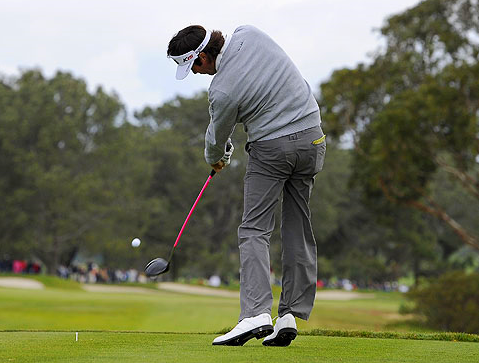A Push for Power
/The more I use the SwingCatalyst pressure plate system the better I have begun to understand how a player generates power effectively. There seems to be a clear difference between "power" swings and "control" swings. Quite similar to the difference between a player hitting a controlled short iron and a player smashing a driver. The difference is all in how the player uses the ground. What does that mean or look like?
Jamie Sadlowski (Golf Digest)
In the above swing sequence notice how much lower long drive champion, Jamie Sadlowski's belt is in frame 4 than it is in frame 3. This is due to the fact that he is lowering his body - essentially lightening himself - in order to jump/explode off the ground coming into impact. Think about if you were to jump - the first thing you do is to go down towards the ground in order to push upward. With faster clubhead speeds I often see a more pronounced jump. Sometimes to the point of the player leaving the ground through impact.
Below you will see the pressure trace from two proven Tour power hitters at impact while smashing the driver. This SwingCatalyst technology tracks where the golfer's center of pressure is located throughout the swing.
These are classic power traces! You will notice that both of these power hitters have more pressure (not necessarily weight) on their back foot at impact. I would expect to see this due to the player pushing so aggressively off the front foot that they have not only pushed their bodies up and just about off the ground, but slightly backwards as well. The interesting thing is that when each of these golfers hits a controlled 8 iron shot their pressure traces don't work onto the back foot at impact - a clear difference.
Bubba Watson
The golf swing is made up of three primary elements: movement, the forces that lead to the movement and the timing of those forces. Clubhead speed can be greatly enhanced by increasing the magnitude of the force and improving the timing of the force. Note: This article is not so much to encourage you to get off the ground through impact with a driver as it is to put your mind at ease should you be doing so. It's okay! I always encourage junior golfers to smash it first and then work towards finding it later. As they learn to smash it I see them:
- lowering down into the front foot early in the downswing
- exploding/jumping/pushing off the ground as they approach, but prior to, impact
- release the wrists freely through the hit
There is a direct correlation between how far or high a person can jump and how far they can hit a golf ball. No wonder Dustin Johnson can dunk a basketball....
A bigger push means bigger power!










